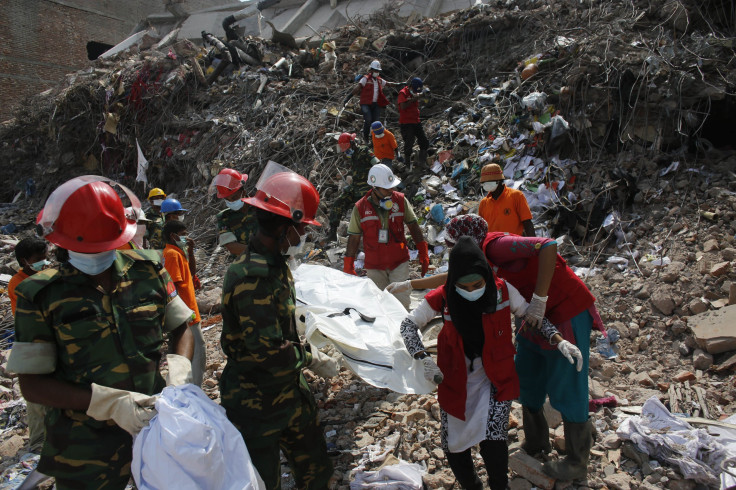Bangladesh Building Collapse Worst Garment Factory Disaster Ever, But There Have Been Many Other Similar Tragedies

Soon after the death toll from last week’s building collapse in Dhaka, Bangladesh, passed the 500 figure, the nation’s finance minister said he did not think the catastrophe would hurt the crucial garment industry that accounts for some 80 percent of the impoverished nation’s exports.
Abul Maal Abdul Muhith downplayed the incident, reported the Associated Press, in a likely effort to defuse accusations that the Bangladesh government was to blame for the shoddy construction of factories packed with poorly paid workers, like the eight-story Rana Plaza building that collapsed.
"The present difficulties ... well, I don't think it is really serious -- it's an accident," he told reporters while visiting New Delhi, India.
"And the steps that we have taken in order to make sure that it doesn't happen, they are quite elaborate and I believe that it will be appreciated by all."
Muhith also shrugged off fears that foreign retailers might withdraw their operations from Bangladesh in the wake of the deadly collapse.
"These are individual cases of ... accidents. It happens everywhere," he stated.
The owner of the Rana Plaza building, Mohammed Sohel Rana, has been arrested and his assets confiscated. He will be charged with negligence, among other offenses, but protesters and workers’ activists are calling for the imposition of the death penalty.
AP also noted that the April 24 collapse in Dhaka may have been the worst garment factory disaster in history in terms of lives lost (hundreds of people still remain missing or unaccounted for).
Just last year in November, a fire in another Bangladesh garment factory killed 112 people. The conditions at the Tazreen Fashions factory were identical to the situation at Rana Plaza -- unsafe conditions and underpaid, overworked employees making cheap clothes for western retailers.
Hundreds of other Bangladeshi garment workers have died in other fires over the past decade. The country has between 3.5 million and 4 million workers toiling in some 4,500 garment factories. As textile manufacturing became too expensive in China, many retailers moved such operations to low-cost Bangladesh.
Just two months prior to the inferno at Tazreen, fires at two factories in Pakistan killed more than 260 people -- 236 died in a garment factory in Karachi; while at least 25 perished in a shoe factory in the city of Lahore.
Factory fires are also quite common in India, although none have led to the kind of carnage witnessed in Dhaka. In late March 2013, a fire at a car-seat production facility outside Bangalore killed six people; a few days prior, a fire at a chemical factory near Mumbai killed five.
Last September, another blaze at a fireworks factory in Tamil Nadu killed 38. In November 2006, a fire at a leather factory in Kolkata killed at least ten people.
As in Bangladesh, safety regulations at many Indian factories are either nonexistent or not properly enforced.
Perhaps the worst garment factory disaster in the U.S. occurred at the Triangle Shirtwaist factory in New York City in March 1911 – a fire trapped and killed 146 people, mostly young women.
That tragedy exposed the dangerous conditions faced by many factory workers in the U.S. and led to the creation of building, fire, and safety codes around the United States.
The immediate aftermath of the Triangle fire was somewhat similar to the current scenario in Bangladesh.
"If you look at the Triangle Fire, at first there was all sorts of finger-pointing to the owners of the factory, to the building inspectors, the Fire Department and other city agencies,” Richard Greenwald, a professor and author in New York told Minnesota Public Radio.
“And what changed that was the protest of workers. Their continuing to protest, their getting out into the streets, put enormous pressure on the political system but also the consumer system. Because it was very hard to buy clothing, knowing this had just happened."
Greenwald added that "factory fires and collapses were fairly normal 100 years ago in industrial America. Workers' lives were fairly cheap."
But Scott Nova, executive director of the Worker Rights Consortium, pointed out a key difference between the 2013 collapse in Bangladesh and the Triangle tragedy from more than a century ago.
"In 1911 the U.S. apparel industry was all in the U.S.," he told MPR.
"The consumers were in the U.S., the retailers were in the U.S., the manufacturers were in the U.S., the brands were in the U.S. So the U.S. government had the power to take effective action, and the U.S. unions had the power directly through their own efforts to bring about change. We now have a global apparel industry. The workers are in Bangladesh; the factory owners, many of them, are based in Bangladesh. But the real power in the industry lies in the United States and Europe, where giant brands and retailers with billions of dollars in revenue call the shots."
© Copyright IBTimes 2024. All rights reserved.




















